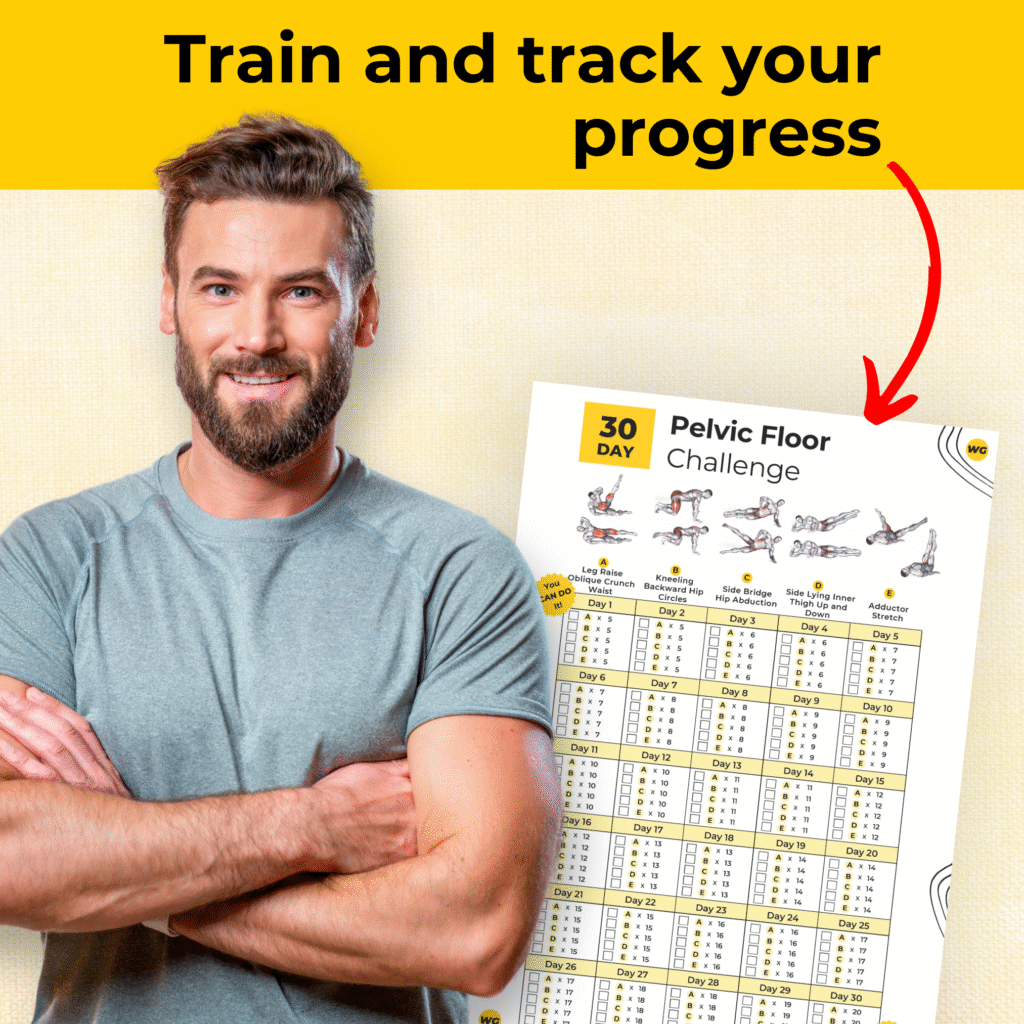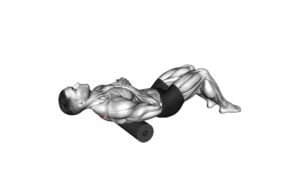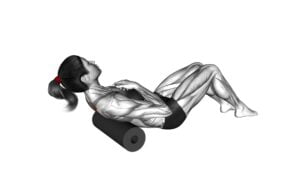Middle Back Stretch (male) – Video Exercise Guide & Tips

Looking to relieve tension in your middle back? Check out this video exercise guide and get tips on the proper form and technique for the middle back stretch.
Watch This Exercise Video
No need for fancy equipment – all you need is your body and a few minutes of your time. Whether you're a beginner or a seasoned fitness enthusiast, there are modifications for every fitness level.
Avoid common mistakes and learn how to incorporate this stretch into your routine for maximum benefits.
Key Takeaways
- Middle back stretches can improve flexibility and posture
- These stretches can help release tension and tightness in the middle back muscles
- Proper form and technique are important for maximizing the benefits of the stretch
- Modifications can be made for different fitness levels, including adaptations for beginners and advanced variations.
Benefits of Middle Back Stretch
You will experience increased flexibility and improved posture through the regular practice of the middle back stretch. This exercise specifically targets the muscles in your middle back, helping to release tension and tightness while promoting a greater range of motion. By incorporating the middle back stretch into your routine, you'll notice that your posture becomes more aligned and upright, as the exercise helps to lengthen and strengthen the muscles that support your spine.
Improved posture is essential for maintaining a healthy spine and reducing the risk of back pain or injury. When your middle back muscles are flexible and strong, they can better support your spine and help you maintain proper alignment throughout the day. This not only improves your overall posture but also reduces the strain and stress placed on your back during daily activities.
Additionally, the middle back stretch can increase your range of motion, allowing you to move more freely and easily. The exercise targets the thoracic spine, which tends to be less mobile compared to other areas of the spine. By regularly stretching and mobilizing the middle back, you can improve your ability to twist, bend, and rotate, which can be beneficial for various activities and sports.
Incorporating the middle back stretch into your fitness routine can have numerous benefits, including improved posture and increased range of motion. By dedicating a few minutes each day to this exercise, you can enhance your overall flexibility and support the health of your spine.
Proper Form and Technique
To perform the middle back stretch properly, focus on maintaining a straight back and engaging your core muscles throughout the exercise. This won't only help you target the muscles in your middle back, but also improve your overall middle back flexibility. Here are three key tips to ensure you have the correct form and technique:
- Start in a standing position with your feet shoulder-width apart. Keep your knees slightly bent and your shoulders relaxed.
- Interlace your fingers and extend your arms forward, parallel to the ground. Inhale deeply, and as you exhale, round your upper back and push your hands away from your body. Feel the stretch in your middle back.
- Hold the stretch for 15-30 seconds, focusing on deep breathing and relaxing your muscles. Repeat the stretch 2-3 times.
By following these guidelines, you can effectively stretch your middle back and improve its flexibility. This will help alleviate any tension or tightness in your back muscles, promoting better posture and reducing the risk of injury.
Now that you know how to perform the middle back stretch with proper form and technique, let's move on to the equipment needed for the stretch.
Equipment Needed for the Stretch
To properly perform the middle back stretch and get the most out of your exercise routine, there's no specific equipment needed. This stretch can be easily done without any additional equipment, making it convenient and accessible for everyone. All you need is your own body and a small amount of space to perform the stretch comfortably. No weights, resistance bands, or machines are required.
However, if you want to modify the stretch or add some variety to your routine, you can incorporate certain equipment. For example, you can use a yoga mat or an exercise mat to provide cushioning and support for your knees and elbows during the stretch. Additionally, if you find it difficult to maintain balance during the stretch, you can use a stability ball or a foam roller to assist you. These pieces of equipment can help you modify the stretch according to your needs and abilities.
Modifications for Different Fitness Levels
To adapt the middle back stretch for individuals with varying fitness levels, modifications can be made to increase or decrease the intensity of the exercise. Here are three adaptations that cater to beginners and advanced individuals:
- Adaptations for beginners:
- Start with a shorter range of motion: If you're new to the middle back stretch, begin by only bending forward slightly until you feel a gentle stretch. Gradually increase the range of motion as your flexibility improves.
- Use a prop for support: Place a yoga block or a rolled-up towel under your knees to provide support and stability during the stretch. This can help beginners maintain proper form and prevent strain on the lower back.
- Perform the stretch seated: If the standing version of the exercise is too challenging, you can modify it by sitting on a chair or bench. This reduces the amount of weight placed on the back and makes it more accessible for beginners.
- Advanced variations:
- Add resistance: Hold a light dumbbell or a resistance band while performing the middle back stretch. This increases the challenge and engages the muscles more intensely.
- Perform the stretch on an unstable surface: Try doing the exercise on a stability ball or a foam roller. This forces the muscles to work harder to maintain balance and stability, providing an advanced variation of the stretch.
- Increase the duration: Hold the stretch for a longer period of time, gradually working your way up to 30 seconds or more. This enhances the intensity and promotes deeper stretching for advanced individuals.
Remember to listen to your body and choose the modifications that best suit your fitness level.
Common Mistakes to Avoid
When performing the middle back stretch, it's important to avoid improper form, as it can put you at risk of injury. Make sure to maintain proper alignment and engage your core muscles throughout the exercise.
Additionally, neglecting to warm up before stretching can decrease your flexibility and increase the likelihood of muscle strains or pulls.
Improper Form Risks Injury
Using improper form during the middle back stretch can increase the risk of injury. It's important to perform this exercise correctly to avoid any potential harm. Here are three common mistakes to avoid when performing the middle back stretch:
- Arching your lower back: This puts excessive strain on your lower spine and can lead to back pain or injury. Keep your lower back flat against the ground or the wall throughout the stretch.
- Jerking or bouncing movements: Rapid and uncontrolled movements can strain the muscles and ligaments in your middle back. Instead, perform slow and controlled movements to stretch the muscles effectively.
- Overstretching: It's crucial to listen to your body and not push beyond your limits. Overstretching can cause muscle strains or even tears. Gradually increase the intensity of the stretch over time.
By avoiding these common mistakes, you can minimize the risk of injury and maximize the benefits of the middle back stretch.
Neglecting warm-up decreases flexibility, so it's important to incorporate a proper warm-up routine before performing this exercise.
Neglecting Warm-Up Decreases Flexibility
Avoid neglecting the warm-up routine before performing the middle back stretch, as it decreases flexibility and increases the risk of injury.
Warm-up exercises are essential for preparing your body for physical activity by increasing blood flow to your muscles and lubricating your joints. They help to improve flexibility, which is crucial for maintaining a full range of motion during the middle back stretch. Neglecting the warm-up can lead to muscle stiffness and tightness, making it harder to perform the stretch effectively.
Additionally, without proper warm-up, you're more likely to strain or pull a muscle while attempting the stretch, resulting in injury. Therefore, it's important to incorporate warm-up exercises into your routine to maximize flexibility and minimize the risk of injury.
Now, let's move on to some tips for incorporating the stretch into your routine.
Tips for Incorporating the Stretch Into Your Routine
To incorporate the middle back stretch into your routine, try adding it as a warm-up exercise before your main workout. This stretch is a great way to increase flexibility and prevent injury. Here are three tips to help you incorporate this stretch effectively:
- Start with a gentle warm-up: Before attempting the middle back stretch, it's important to warm up your muscles. This can be done through light cardio exercises such as jogging or jumping jacks. A warm-up helps increase blood flow to the muscles and prepares them for stretching.
- Perform the stretch correctly: To ensure you get the most out of the middle back stretch, it's crucial to maintain proper form. Sit on the floor with your legs extended in front of you and your back straight. Reach your arms forward, then slowly lean back, allowing your upper body to relax into the stretch. Hold for 20-30 seconds and repeat as needed.
- Incorporate it into your routine regularly: Consistency is key when it comes to flexibility training. Aim to incorporate the middle back stretch into your routine at least 2-3 times per week. You can do it before or after your workout, or even on rest days to promote recovery.
Frequently Asked Questions
How Often Should I Perform the Middle Back Stretch?
To improve your middle back flexibility, it's recommended to perform the middle back stretch regularly.
This exercise has numerous benefits, such as relieving tension, improving posture, and reducing the risk of back pain.
By incorporating the middle back stretch into your routine, you can maintain a healthy and flexible spine.
Remember to consult with a professional if you have any concerns or specific conditions before starting any exercise program.
Can the Middle Back Stretch Help Alleviate Lower Back Pain?
Performing the middle back stretch can indeed help alleviate lower back pain. By targeting the muscles in your middle back, this stretch helps to improve flexibility and relieve tension in the surrounding areas.
Stretching the middle back can also promote better posture, which can in turn reduce strain on the lower back.
Incorporating this stretch into your regular routine can provide numerous benefits for both your middle and lower back, helping to alleviate pain and improve overall comfort.
Is It Safe to Perform the Middle Back Stretch if I Have a Previous Back Injury?
If you have a previous back injury, it's important to take precautions when performing the middle back stretch.
Consult with a healthcare professional or a physical therapist to determine if it's safe for you to do. They can provide guidance on modifications or alternative stretches that may be more suitable for your condition.
Prioritizing safety and seeking professional advice is crucial to prevent further injury and promote healing.
Can the Middle Back Stretch Help Improve Posture?
Yes, the middle back stretch can help improve your posture.
By stretching the muscles in your middle back, you can increase your flexibility and prevent hunching.
This exercise targets the muscles that are responsible for maintaining good posture, allowing you to stand up straighter and avoid slouching.
Incorporating the middle back stretch into your routine can be an effective way to improve your overall posture and maintain a healthy spine.
Are There Any Specific Breathing Techniques I Should Follow While Performing the Middle Back Stretch?
When performing the middle back stretch, it's important to focus on your breath. Incorporating specific breathing techniques can enhance the benefits of this exercise.
For example, try deep belly breathing, inhaling through your nose and exhaling through your mouth. This can help you relax and deepen the stretch.
Another option is to synchronize your breath with the movement, inhaling as you lengthen and exhaling as you release. These breathing techniques can enhance your yoga or meditation practice while performing the middle back stretch.
Conclusion
Incorporating the middle back stretch into your routine can provide numerous benefits, such as improving flexibility and relieving tension in the back muscles.
To perform this stretch correctly, ensure proper form and technique, and consider using equipment like a foam roller or yoga block for support.
Modifications are available to accommodate different fitness levels, and it's important to avoid common mistakes to prevent injury.
Follow these tips and enjoy the benefits of a well-stretched middle back.

Author
Years ago, the spark of my life’s passion ignited in my mind the moment I stepped into the local gym for the first time. The inaugural bead of perspiration, the initial endeavor, the very first surge of endorphins, and a sense of pride that washed over me post-workout marked the beginning of my deep-seated interest in strength sports, fitness, and sports nutrition. This very curiosity blossomed rapidly into a profound fascination, propelling me to earn a Master’s degree in Physical Education from the Academy of Physical Education in Krakow, followed by a Sports Manager diploma from the Jagiellonian University. My journey of growth led me to gain more specialized qualifications, such as being a certified personal trainer with a focus on sports dietetics, a lifeguard, and an instructor for wellness and corrective gymnastics. Theoretical knowledge paired seamlessly with practical experience, reinforcing my belief that the transformation of individuals under my guidance was also a reflection of my personal growth. This belief holds true even today. Each day, I strive to push the boundaries and explore new realms. These realms gently elevate me to greater heights. The unique combination of passion for my field and the continuous quest for growth fuels my drive to break new ground.







